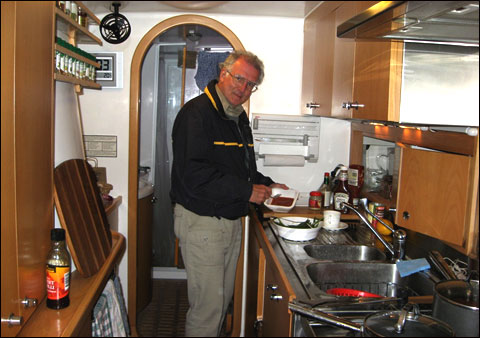| The galley in our catamaran is down in the port hull slightly aft of amidships. I insisted on a galley down rather than up on the bridge deck as
I do not want the mess and smell of cooking and the dirty dishes, sharing our company as we dine and relax afterwards.
 |
Visiting chef settles into galley |
The galley is 10 feet long and the aisle is narrow enough that I can securely brace myself wherever I am working and yet wide enough that, as my husband says, "2 people can ease past each other without first having to propose marriage."
- On the inboard side, fore to aft, we have a refrigerator under the counter top with a work surface and a stainless steel draining board on top. A wooden board fits snugly over the large sink whenever two people are preparing a meal together.
- On the forward bulkhead there is a clever device that holds rolls of paper towels, aluminum foil and cling wrap. Next, under the double stainless steel sinks (1 small and 1 large with a snugly fitting draining rack that stores away in it) is a large cupboard where we store all
our cleaning materials plus a few handy-dandy items such as the WD-40 that
my husband is always calling out for when I am cooking.
- At the aft end is a
3 burner propane stove with an oven containing a grill. Under the stove
is a deep drawer that contains my pots and pans. We have a wooden work
surface that sits on the stove but it is seldom used as we usually don't
need any more counter top space than we have. Over the stove is a stainless steel range
hood with a fan. Behind the counter are large, very deep cupboards. The
top shelves of these hold plates, serving dishes and unused storage
containers. The bottom shelves hold a stainless steel microwave oven forward ($49.95 at
London Drugs in Canada) and a large assortment of frequently used
foodstuffs, coffee, tea, cocoa, mustard, crackers etc.
- In the centre half of the outboard side of the galley is my pantry where I
store plastic containers of dry goods plus bottles of vinegars, sauces and
the like. At the forward end of this very tall pantry cupboard is a liquor
locker that holds all that we can drink in a year. On either side of the
pantry are counters that have been gradually given over to baskets of fresh
fruits and vegetables, a bread box and a corner for boxes or bottles of
wine. Below counter-top level we have a garbage bin forward, drawers for
storing cutlery and cooking utensils, a bin for storing potatoes and onions
and another bin for rolls of foil and kitchen wrap and larger utensils.
Under the aft end is a three-level "goodies locker" crammed with treats to
suit each crewmember's tastes.
We have an 1800 watt inverter and 765 AH of 12 volt batteries powered by the
two 85 amp engine alternators, 290 watts of solar panels on top of our hard
dodger, a KISS wind generator and a small Honda 1000 EU gasoline generator all of which come into play almost every week.
|
|